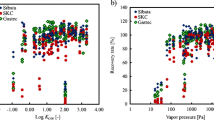Abstract
Indoor fabric surfaces (e.g., clothes, curtains, and bedding sheets) can adsorb volatile organic compounds (VOCs) in wildfire smoke penetrating indoors. Meanwhile, the VOCs can be desorbed from the surfaces and re-emitted to air and linger indoors longer than a wildfire event. This preliminary study analysed the composition of VOCs in the oak-burning smoke and then measured the concentrations of six common VOCs (Guaiacol, 4-ethyl-2-methoxyphenol, 4-methyl-1,2-Benzenediol, 2,6-dimethoxyphenol, Vanillin, and 2-methoxy-4-propylphenol) adsorbed on cotton fabric for seven different exposure durations (0.16, 0.5, 1, 2, 4, 8, and 12 h). Smoke was generated by burning chips of oak, a common tree in California. The chemical analysis was conducted with gas chromatography-mass spectrometry (GCMS). We identified 46 organic compounds in the smoke from the fabric extractions. The results show that VOC accumulation on the cotton fabric increased with exposure time within 12 h and varies from chemical to chemical. The measured adsorption concentration reached 48.71 µg/kg (mass of VOC/mass of fabric) for 4-methyl-1,2-Benzenediol and 3.59 µg/kg for 4-ethyl-2-methoxyphenol corresponding to the highest and the lowest after a 12 h exposure.
Access this chapter
Tax calculation will be finalised at checkout
Purchases are for personal use only
Similar content being viewed by others
References
Austin CC, Wang D, Ecobichon DJ, Dussault G (2001) Characterization of volatile organic compounds in smoke at municipal structural fires. J Toxicol Environ Health A 63(6):437–458. https://doi.org/10.1080/152873901300343470
Bari MA, Baumbach G, Kuch B, Scheffknecht G (2010) Temporal variation and impact of wood smoke pollution on a residential area in southern Germany. Atmos Environ 44(31):3823–3832
Brito DQ, Passos CJS, Muniz DH, Oliveira-Filho EC (2017) Aquatic ecotoxicity of ashes from Brazilian savanna wildfires. Environ Sci Pollut Res 24(24):19671–19682
Fine PM, Cass GR, Simoneit BRT (2022) Chemical characterization of fine particle emissions from the fireplace combustion of wood types grown in the Midwestern and Western United States. Environ Eng Sci. https://www.liebertpub.com/doi/abs/10.1089/109287504323067021. Accessed 09 May 2022
Gaman T, Firman J (2006) Oaks 2040: the status and future of oaks in California. California Oak Foundation Oakland, CA, USA
Harper AR et al (2019) Chemical composition of wildfire ash produced in contrasting ecosystems and its toxicity to Daphnia magna. Int J Wildland Fire 28(10):726–737
Katsoyiannis A, Leva P, Kotzias D (2008) VOC and carbonyl emissions from carpets: a comparative study using four types of environmental chambers. J Hazard Mater 152(2):669–676. https://doi.org/10.1016/j.jhazmat.2007.07.058
Liu X et al (2017) Airborne measurements of western US wildfire emissions: comparison with prescribed burning and air quality implications. J Geophys Res Atmos 122(11):6108–6129
Morrison G, Shakila NV, Parker K (2015) Accumulation of gas-phase methamphetamine on clothing, toy fabrics, and skin oil. Indoor Air 25(4):405–414
Nolte CG, Schauer JJ, Cass GR, Simoneit BR (2001) Highly polar organic compounds present in wood smoke and in the ambient atmosphere. Environ Sci Technol 35(10):1912–1919
Park RJ, Jacob DJ, Logan JA (2007) Fire and biofuel contributions to annual mean aerosol mass concentrations in the United States. Atmos Environ 41(35):7389–7400
Poirot RL, Husar RB (2004) Chemical and physical characteristics of wood smoke in the northeastern US during July 2002 impacts from Quebec forest fires
PubChem (2022a) 4-Ethyl-2-methoxyphenol. https://pubchem.ncbi.nlm.nih.gov/compound/62465. Accessed 22 May 2022
PubChem (2022b) 2,6-Dimethoxyphenol. https://pubchem.ncbi.nlm.nih.gov/compound/7041. Accessed 22 May 2022
PubChem (2022c) 2-Methoxy-4-propylphenol. https://pubchem.ncbi.nlm.nih.gov/compound/17739. Accessed 22 May 2022
Querol X et al (2009) African dust contributions to mean ambient PM10 mass-levels across the Mediterranean Basin. Atmos Environ 43(28):4266–4277
Rogge WF, Hildemann LM, Mazurek MA, Cass GR, Simoneit BR (1998) Sources of fine organic aerosol. 9. Pine, oak, and synthetic log combustion in residential fireplaces. Environ Sci Technol 32(1):13–22
van Drooge BL et al (2016) Detection and simulation of wildfire smoke impacting a Mediterranean urban atmosphere. Atmos Pollut Res 7(3):494–502
Vanillin toxicity reports, review—hazard potential, risk. https://www.bibra-information.co.uk/downloads/toxicity-profile-for-vanillin-1990/. Accessed 22 May 2022
Verma V, Polidori A, Schauer JJ, Shafer MM, Cassee FR, Sioutas C (2009) Physicochemical and toxicological profiles of particulate matter in Los Angeles during the October 2007 southern California wildfires. Environ Sci Technol 43(3):954–960
Vicente A et al (2011) Measurement of trace gases and organic compounds in the smoke plume from a wildfire in Penedono (central Portugal). Atmos Environ 45(29):5172–5182
Won D, Corsi RL, Rynes M (2000) New indoor carpet as an adsorptive reservoir for volatile organic compounds. Environ Sci Technol 34(19):4193–4198
Acknowledgements
The study is funded by Worcester Polytechnic Institute.
Author information
Authors and Affiliations
Corresponding author
Editor information
Editors and Affiliations
Rights and permissions
Copyright information
© 2023 The Author(s), under exclusive license to Springer Nature Singapore Pte Ltd.
About this paper
Cite this paper
Wang, C., Liang, Y., Yao, W., Bergendahl, J., Liu, S. (2023). Indoor Fabric as an Adsorptive Reservoir for Volatile Organic Compounds in Wildfire Smoke: A Preliminary Study. In: Wang, L.L., et al. Proceedings of the 5th International Conference on Building Energy and Environment. COBEE 2022. Environmental Science and Engineering. Springer, Singapore. https://doi.org/10.1007/978-981-19-9822-5_250
Download citation
DOI: https://doi.org/10.1007/978-981-19-9822-5_250
Published:
Publisher Name: Springer, Singapore
Print ISBN: 978-981-19-9821-8
Online ISBN: 978-981-19-9822-5
eBook Packages: EngineeringEngineering (R0)




